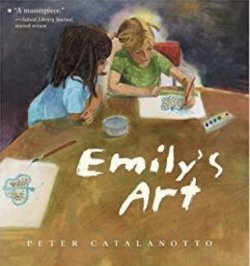Gareth B. Matthews

Review of Emily’s Art by Peter Catalanotto (New York: Simon & Schuster, 2001). Originally published in Thinking: The Journal of Philosophy for Children 17(3): 3.
On Monday Ms. Fair tells her first-grade class that there will be an art contest on Friday. A prize ribbon, she explains, will be given to the best painting in each grade.
“How will we know which is best?” asks Emily.
“A judge will decide that,” explains Ms. Fair.
The children begin discussing the idea of a contest. They argue over whether chocolate or vanilla is best. “Does the judge know which is better?” asks Emily.
Ms. Fair begins to respond to Emily’s question when Jake asks whether, if he loses the contest, the judge will put him in jail. Ms. Fair reassures Jake that he needn’t worry about that, but she never returns to deal with Emily’s crucial question.
Later on that day Emily paints a butterfly. Emily’s best friend, Kelly, is wowed by Emily’s butterfly. She asks Emily to show her how to paint a butterfly. Emily does. Emily then paints a picture of her family. The next day she paints a glowing picture of Ms. Fair. Kelly paints a red butterfly that day.
The next day Emily paints a gorgeous picture of herself with Kelly. Kelly herself paints a purple butterfly that day. The next day Emily paints a colorful picture of her dog, Thor. Kelly paints a green butterfly. That day Ms. Fair tells the children to choose their favorite painting for the contest.
Emily chooses her painting of Thor, which is now her favorite painting. Emily doesn’t sleep well that night. She is worried about the contest and about how the judge will decide which painting is best.
On Friday morning the children go to the gym, where the walls are filled with their paintings. Soon the judge arrives and begins looking at each of the artworks on the walls of the gym. She is immediately attracted to Emily’s bright and engaging picture of Thor. But she takes Thor to be a rabbit. And she likes rabbits. Told that the animal is not a rabbit, but a dog, she reacts with repulsion. It seems a dog once attacked her and tore her dress. She awards the prize ribbon to Kelly’s butterfly instead of Emily’s dog.
Shocked by her loss, Emily resolves not to paint again. She begins to feel faint. Ms. Fair, noticing how bad Emily looks, drops her off at the office of the school nurse.
I won’t reveal how this engaging and beautifully illustrated story ends, except to say that Emily survives her trauma, as does her friendship with Kelly. And we readers are left to ponder the judge’s failure of taste and the grander question of how aesthetic judgment should be understood.
I was put onto this story by Professor Thomas Wartenberg, who was himself introduced to it by one of his students at Mt. Holyoke College. Tom teaches a course there that prepares college students to do philosophy with the kids in a nearby elementary school. One of the early assignments in Tom’s college class is to find a children’s story that invites philosophical discussion, perhaps by problematizing a concept that the children can discuss. One of Tom’s students chose Emily’s Art.
It was an inspired choice. The story puts out the suggestion that aesthetic judgment is entirely subjective, like preferring vanilla to chocolate, or winter to summer. But, if that is right, there can hardly be much point in having an art contest. All we could learn from the contest is something about the purely subjective preferences of the judge.
In fact what we learn about the judge in the story is that she likes rabbits and butterflies, but not dogs. And for this reason she likes pictures of butterflies and rabbits, but not pictures of dogs.
If we are honest, we will have to admit that, and for most of us, what paintings are paintings of will very likely play at least some minimal role in whether we prefer one painting over another. But surely that can’t be all there is to aesthetic judgment, can it? If not, why not? Can we come up with some argument to show that there must be more to it than that?
Well, a good first thing to say is that there might be two or more paintings of butterflies, or of rabbits. And surely it makes sense to say that one painting of a butterfly could be a better painting than another. Now what could be a good reason for saying that one painting is a better painting of a butterfly or rabbit than another?
The attractive reproductions in this book make clear that Emily can use colors boldly and imaginatively. Thus, asked why she has given Ms. Fair wings (the bright yellow wings stand out against the purple dress and shoes Ms. Fair is wearing in Emily’s picture), Emily explains, “Because she’s so nice, like an angel.”
The children who discuss Emily’s Art with you, or in your class, may not be able to agree on what criteria the judge should have used in judging this art contest. But there are ample materials in this beautifully illustrated and provocative storybook to move them away from the idea that judging an art contest is, or ought to be, like deciding whether to have a chocolate or vanilla ice cream.
